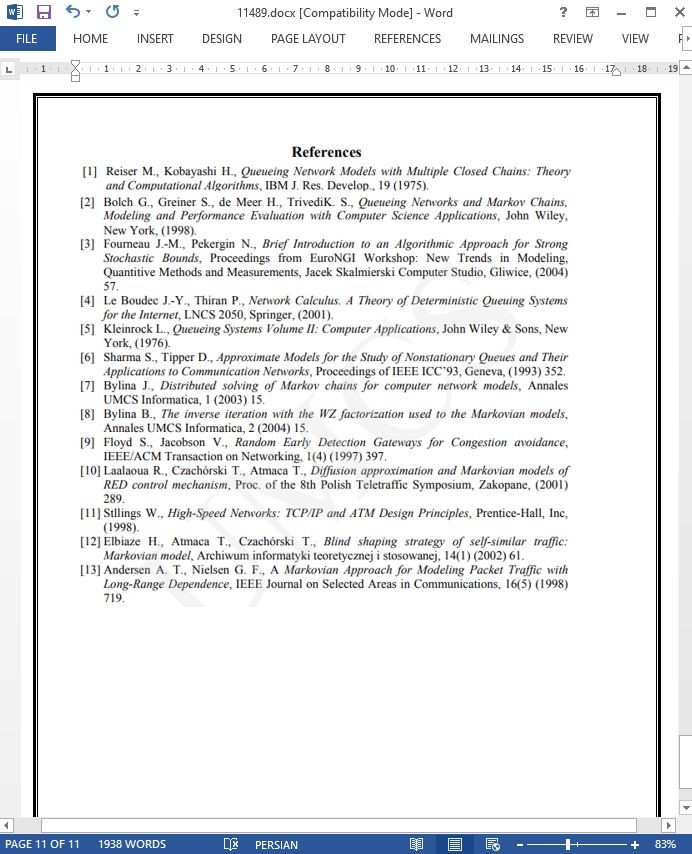
استفاده از زنجیره های مارکوف برای مدل سازی شبکه ها
چکیده
پژوهش شامل مرور و بحث بر روی مدلسازی شبکههای ارتباطی با استفاده از مدلهای صف و زنجیرههای مارکوف میباشد. این پژوهش چگونگی حساب کردن مشخصههای متنوع در سیستمهای حقیقی مانند مکانیزمهای کنترلی مشخص و خودتشابهی ترافیکی را نشان میدهد. دو مکانیزم همراه با زنجیرههای مارکوف مدلسازی شده است و الگوریتم RED در TCP/IP و یک شکلدهی ترافیک خودتشابهی ارائه گردیده است.
1- مقدمه
امروزه شبکه های ارتباطی بسیار پیچیده گردیدهاند. آنها اجازه ذخیره سازی، پردازش و انتقال مقدار عظیمی از دادهها را میدهند. اینترنت (مانند یک رسانهی اطلاعات جهانی) و رشد آن یک مثال از ظرفیتهای شبکه میباشد. فعالیتهای شبکهی ارتباطی به فاکتورهای زیادی بستگی دارد که به یکدیگر مرتبط میباشند. آنها جهت انجام دادن بسیار بهتر نیازهای متنوع کاربران بهبود پیدا کردهاند.
جهت پیش بینی کردن فعالیت یک شبکه به ابزارهای مناسبی نیاز میباشد تا بتوان شبکه و کارهای آن را ارزیابی کرد. مدلسازی شبکههای ارتباطی همانند یک ابزار میباشد. این مدلسازی اجازهی تخمین زدن رفتار شبکهی را در مرحلهی پروژه، موقعیتسنجی نقاط ازدحام و گلوگاهها، پیدا کردن تلفات بستهی احتمالی و بارهای پیک در المانهای شبکه میدهد. با استفاده از مدلسازی، میتوان جانمایی، ساختارها و تنظمیات را مقایسه نمود و استفاده از منابع را بهینه کرد.
Abstract
The paper contains the review and the discussion on modelling communication networks with the use of queuing models and Markov chains. It shows how to take into account various characteristics of real systems – like some control mechanisms and the traffic self-similarity. There are presented two mechanisms modelled with Markov chains: the RED algorithm in TCP/IP and a self-similar traffic shaping.
1. Introduction
Communication networks are getting more and more complicated nowadays. They allow storing, processing and transferring an enormous amount of data. Internet (as a global information medium) and its growth is an example of the network capabilities. Communication network activities depend on many factors, related to each other. They are being improved to fulfil more and more elevated and various users’ needs.
To anticipate a network activity, one needs suitable tools that can evaluate the network and its work. Communication networks’ modelling is such a tool. It allows estimating behaviour of the network at the project stage, localizing congestion points and bottlenecks, finding packet loss probabilities and peak loads of network elements. With modelling, one can compare topologies, architectures and configurations and optimise the use of the resources.
چکیده
1- مقدمه
2- زنجیرههای مارکوف
3- مدلسازی مکانیزم RED
4- مدلسازی خودتشابهی
5- نتیجهگیری
Abstract
1. Introduction
2. Markov chains
3. Modelling the RED mechanism
4. Modelling self-similarity
5. Conclusions
- ترجمه فارسی مقاله با فرمت ورد (word) با قابلیت ویرایش، بدون آرم سایت ای ترجمه
- ترجمه فارسی مقاله با فرمت pdf، بدون آرم سایت ای ترجمه



